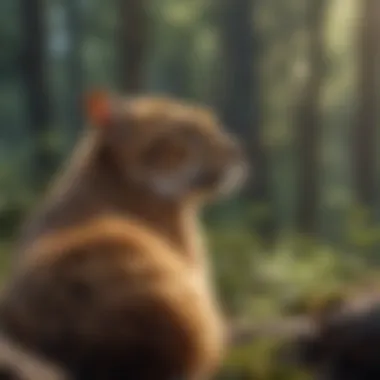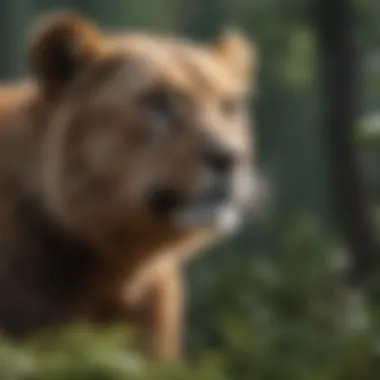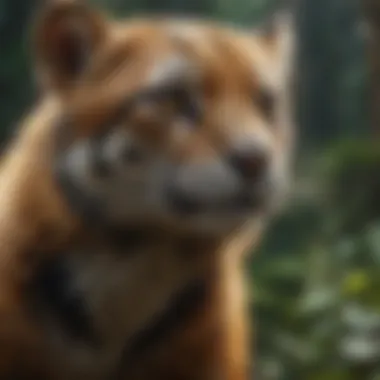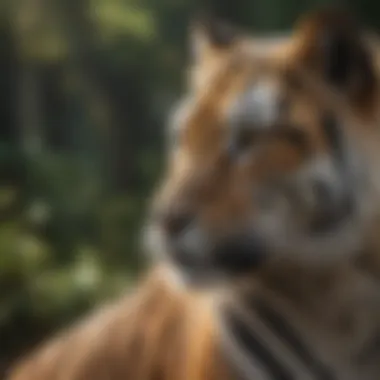The Critical Role of Animal Conservation in Our World


Nature Topic Overview
Animal conservation is more than just a trendy phrase tossed around in eco-friendly circles. It represents a vital effort to protect the natural world and the diverse species that inhabit it. Think of it as a big umbrella that covers everything from giant elephants thundering across the savanna to tiny insects buzzing around your garden. Each creature, big or small, plays a part in its ecosystem and contributes to the complex web of life.
When we talk about animal conservation, we’re diving into why it's important for us to take action. It's not just about saving the endangered bald eagle or the mighty rhino; it’s also about maintaining biodiversity. This term may sound scientific, but it's a simple concept: it refers to the variety of life on Earth. A rich diversity means healthier ecosystems, which directly affects our own well-being and our planet's health.
Fun Facts and Trivia
Did you know that some sea turtles can hold their breath for up to five hours? Or that a group of flamingos is called a "flamboyance?" These quirky facts not only entertain but they also remind us of the incredible variety among animal species. Here are a few more interesting tidbits:
- Axolotls can regenerate their limbs.
- An octopus has three hearts!
- The world's smallest mammal is the bumblebee bat, weighing about the same as a penny.
These wonderfu creatures remind us why conservation efforts matter; each unique species contributes to the rich tapestry of our world.
Wildlife Explorations
Conservation efforts are crucial for both well-known and lesser-known species. Take the snow leopard, for instance. These graceful cats roam the snowy mountains of Central Asia. They are elusive, rarely seen, yet they face threats from habitat loss and poaching.
Then there is the tiger, a majestic creature that can only be found in small areas of Asia due to deforestation and human encroachment. Their dwindling numbers serve as a reminder of the fragility of life.
Every species has a role to play:
- Predators, like wolves, keep herbivore populations in check.
- Pollinators, such as bees, are vital for plant reproduction.
- Decomposers, like earthworms, enrich the soil.
By understanding the roles of these different animals and supporting their preservation, we promote a healthier planet.
Environmental Awareness
Conservation isn't just about protecting animals; it's also about promoting awareness and sustainability. Humans have a significant impact on animal habitats — whether through urban development, pollution, or climate change. Therefore, it is crucial that we take responsibility for our actions.
Here are some simple tips to help children participate in conservation:
- Reduce, reuse, and recycle items at home.
- Start a small garden to learn about plants and insects.
- Participate in local clean-up days at parks or beaches.
These actions not only help the environment but also instill a sense of responsibility and empathy towards animals.
DIY Nature Activities
Hands-on activities make learning about conservation exciting. Here are some ideas to encourage creativity and appreciation for nature:
- Create a Bird Feeder - Use peanut butter and birdseed on a pine cone to attract local birds to your yard.
- Make a Nature Journal - Document local wildlife sightings and plants found in the neighborhood.
- Visit a Nature Reserve - Explore local parks or wildlife refuges to see conservation efforts in action.
- Host a Nature Scavenger Hunt - Create a list of items found in nature and see who can find them all!
By engaging with nature directly, children can form a lifelong bond with the environment and understand the importance of conservation.
In the grand scheme of things, protecting animals is also about safeguarding our own future. Every small effort counts, and together we can make a difference.
The Role of Animals in Ecosystems
Animal conservation is not just about protecting endangered species; it’s about recognizing the intricate web of life that these creatures are part of. Animals play vital roles in ecosystems, influencing everything from the propagation of plants to the health of waterways. By appreciating this, we can understand why conserving them isn’t merely a noble cause but an essential part of maintaining the planet’s health.
Understanding Ecosystem Services
Ecosystem services are the benefits that humans derive from ecosystems, which include clean air, water, and pollination. Animals contribute significantly to these services in several ways:
- Pollination: Many crops and wild plants rely on animals, particularly insects like bees and butterflies, for pollination. Without them, food systems could collapse.
- Seed Dispersal: Animals like birds and squirrels play a role in spreading seeds across the environment, which helps new plants grow and contributes to forest regeneration.
- Prey-Predator Dynamics: The balance between predator and prey maintains the health of populations and helps control species’ numbers, ensuring no one species overwhelms an ecosystem.
- Nutrient Cycling: Animals contribute to nutrient cycling by breaking down and decomposing organic matter, which enriches the soil and supports plant growth.
Understanding these services highlights an important message: conservation efforts can lead to healthier ecosystems that ultimately benefit humanity.
The Interdependence of Species
In nature, every organism is part of a larger community. Consider this: when one species is threatened or goes extinct, the ripple effects can touch numerous other species. For example:


- Keystone Species: These are species that hold significant importance within their ecosystems. If a keystone species, like the sea otter, is removed, it can trigger a domino effect, leading to the collapse of its habitat.
- Symbiotic Relationships: Many animals depend on each other in various ways. For instance, clownfish and sea anemones provide shelter and protection, showcasing how reliant species can be on one another.
- Food Chains: Each species has its place in the food web. If apex predators, like wolves, are removed, deer populations may soar, which can lead to overgrazing and damage to the vegetation that supports various life forms.
“The loss of one species can lead to the loss of others, highlighting the delicate balance that conservation seeks to protect.”
Recognizing this interdependence fosters a deeper appreciation for the necessity of animal conservation. Each animal is a thread in a greater tapestry, and the loss of one can unravel the fabric of an ecosystem. Thus, the importance of animal conservation is not just about saving a species; it’s about safeguarding a shared future for all beings on Earth.
Current Threats to Wildlife
Understanding the importance of the topic "Current Threats to Wildlife" helps us grasp the pressing challenges that our planet’s animals face today. These threats aren’t just mere footnotes in environmental studies; they’re alarm bells ringing for ecosystems across the globe. Each threat contributes to a cascading effect that not only puts animals in jeopardy but also disrupts the delicate fabric of life itself. Recognizing these threats aids in appreciating the efforts needed to conserve wildlife and highlights the shared responsibility we have to address these pressing issues.
Habitat Loss and Fragmentation
Animal habitats are crucial for their survival, offering food, shelter, and space to thrive. Unfortunately, human expansion—whether through urban development, agriculture, or deforestation—leads to the loss of these vital habitats. Imagine schools and playgrounds disappearing from your neighborhood, forcing you to crowd into a small area. That’s what happens to animals when their habitats are fragmented.
When large areas of land are divided into smaller patches, animals are forced to explore unfamiliar territories. This often leads to clashes with humans or increased competition for dwindling resources. Furthermore, many species rely on vast landscapes to migrate or find mates. The loss of these routes can push them closer to extinction.
"Preserving habitats is like keeping the doors open for animals to thrive. Close those doors, and we risk losing them forever."
Climate Change Impacts
Climate change has swept in like a thick fog, making it hard for wildlife to breathe easy. Shifting weather patterns, increased temperatures, and rising sea levels threaten the delicate balances that species maintain with their environments. Animals have evolved over centuries to adapt to specific climates. A change in temperature can displace them or alter their food sources.
For instance, polar bears rely on sea ice to hunt seals. As temperatures rise, the ice melts, making their hunt more challenging. In many places, plants bloom earlier due to warmer weather, causing a mismatch between food availability and the animals that rely on them. This domino effect demonstrates how climate change is reshaping wildlife’s availability and adaptation.
Poaching and Illegal Trade
Poaching is a major threat, driven largely by the illegal wildlife trade. Think of poaching as a dark shadow lurking where it shouldn't be—it's motivated by greed and the demand for animal parts. This isn’t just about sad pictures of animals like elephants, lions, and rhinos. It signals the end of species and ecosystems as their populations dwindle. Animals hunted for their bones, skins, or horns face an imminent extinction threat.
This illegal activity not only impacts animals but also devastates local communities that rely on eco-tourism. When animals disappear, so do jobs that support their families. Fighting this battle requires both enforcement and education, as communities play a vital role in protecting their wildlife.
Pollution and Its Effects
Pollution is another unseen enemy for wildlife. Whether it’s plastic waste, chemicals, or noise, pollution seeps into every corner of our world. Many animals mistakenly ingest plastic, thinking it’s food, which can lead to choking and serious health issues. Water pollution affects aquatic life, further diminishing the populations of fish and other species critical to the food web.
Birds that hunt for fish contaminated with chemicals may face reproductive challenges too. It’s a vicious cycle that puts stress not only on the affected species, but also on the ecosystems they inhabit. When we address pollution, we are taking steps towards healthier wildlife populations and cleaner environments.
In summary, the various threats current wildlife face highlight an urgent need for awareness and action. From habitat loss and climate change to poaching and pollution, pressing matters demand attention and collective response from humans. By understanding these challenges, we can pave the way toward conservation that is not just about saving animals but also about preserving the irreplaceable ecosystems that we all depend on.
Conservation Strategies
Conservation strategies are a cornerstone of preserving our planet's wildlife and their habitats. These efforts not only bolster the survival of various species but also ensure the overall health of ecosystems. Without effective strategies, many animals may face extinction, leading to dire consequences for both nature and human beings. Therefore, it’s crucial to highlight the various approaches to animal conservation.
Protected Areas and Wildlife Reserves
One of the most prominent conservation strategies involves the creation of protected areas and wildlife reserves. These designated zones serve as safe havens for animals, free from the threats of development and poaching. For instance, consider the Yellowstone National Park in the United States. Established in the 19th century, it has allowed diverse species like wolves and bison to flourish in a controlled environment where human interference is limited.
Having such spaces is not just vital for animal protection; it also helps in maintaining biodiversity. These areas function as natural laboratories, enabling scientists to study ecological dynamics while also providing opportunities for ecotourism. Essentially, they contribute to sustaining ecosystems while bringing awareness to the importance of wildlife conservation.
Community Involvement in Conservation
Another significant strategy is the involvement of local communities in conservation efforts. People living near wildlife hotspots often hold the keys to successful conservation. Their knowledge of the land and its inhabitants can turn them into valuable allies. For example, in Kenya, the Maasai communities have partnered with conservation organizations to protect their grazing lands while preserving wildlife. By educating locals about the benefits of conservation, such as eco-friendly tourism, communities are more likely to participate actively and protect endangered species.
This dual approach recognizes that human and wildlife coexistence is possible. When communities understand the value of biodiversity, they take pride in preserving it for future generations.
Legislation and Policies for Protection
Legislation plays a critical role in conservation. Various laws and policies enforce rules against poaching, illegal trade of wildlife, and habitat destruction. Global agreements like the Convention on International Trade in Endangered Species (CITES) help to regulate the trade of threatened species worldwide. These policies act as protective shields for vulnerable wildlife. Additionally, countries often have their own laws, such as the Endangered Species Act in America, that provide legal frameworks for protecting crucial habitats. This firm ground lays the essentials for sustainable conservation practices, ensuring that wildlife are not exploited and their environments remain intact.
Restoration of Ecosystems
Restoring ecosystems is another essential component of effective conservation techniques. Over time, human activity—be it deforestation or pollution—damages natural habitats. Restorative efforts aim to bring back these environments to their original states.
Take the wetlands, for example. They are incredibly important for many species, including migratory birds. Various organizations have made concerted efforts to restore these critical habitats in places like Louisiana, where restoration projects have revitalized both the ecosystem and local communities reliant on it.
Such endeavors not only revive struggling populations but also enhance ecosystem services, providing cleaner water and mitigating climate effects.
"If we don’t protect our natural resources, future generations will not be able to enjoy the beauty and wonder of nature as we do today."
The Importance of Biodiversity


Biodiversity is more than just a buzzword; it's the lifeblood of our planet. It refers to the variety of life forms on earth, encompassing everything from minuscule microbes to towering trees and the multitude of creatures that inhabit different ecosystems. Understanding the importance of biodiversity is critical for sustaining our environments, economies, and health.
Why Biodiversity Matters
Biodiversity matters for several compelling reasons:
- Ecosystem Resilience: Diverse ecosystems can better withstand and recover from disasters, whether natural events like hurricanes or human-induced challenges like pollution.
- Resource Availability: The variety of plants and animals is crucial for resources like food, medicines, and raw materials, which many communities depend on.
- Cultural Significance: Many cultures identify deeply with local flora and fauna, and preserving these species protects cultural heritage.
Also, biodiversity plays a vital role in regulating the climate. For example, healthy forests, which are rich in biodiversity, absorb carbon dioxide, alleviating the effects of climate change.
"Biodiversity is a shield that protects our ecosystems and communities."
Link Between Biodiversity and Human Health
The connection between biodiversity and human health cannot be overlooked. Here are some key points to consider:
- Medicinal Resources: Many modern medicines are derived from plants and animals. When biodiversity dwindles, we risk losing valuable potentials for discovering new treatments.
- Food Security: A diverse diet is essential for good health. Biodiversity ensures that we have a variety of crops, offering different nutrients and flavors while ensuring our food systems can adapt to changes like disease or climate shifts.
- Mental and Physical Well-Being: Green spaces rich in biodiversity reduce stress and enhance our moods. Studies show that children who play in diverse natural settings display fewer behavioral issues and improved mental health.
In essence, protecting biodiversity is not merely an environmental concern; it's about ensuring the health and well-being of everyone on this planet, now and for future generations.
For further information on the significance of biodiversity, consider visiting Wikipedia or Britannica.
The Role of Education in Conservation
Education plays a pivotal role in conservation efforts, acting as the backbone that supports awareness, understanding, and action. Educating children and adults alike about the delicate balance of nature can spark a passion for wildlife protection and an appreciation for biodiversity. Without knowledge, it’s difficult for individuals to grasp the importance of conservation, which often leads to indifference or uninformed decisions that can harm the environment.
Moreover, when communities are educated, they are more likely to participate in conservation efforts. It creates a ripple effect where informed citizens become advocates for change, influencing their families, peers, and neighbors. Ultimately, education empowers people to make informed choices that contribute positively to wildlife conservation.
Raising Awareness through Engagement
Engagement is a fundamental component of education in conservation. It pushes individuals beyond passive learning, allowing them to experience firsthand the intricacies of ecosystems and the role every creature plays within them. Programs that encourage active participation, such as guided nature walks, volunteer opportunities, or community wildlife projects, bring people closer to nature.
For instance, a school might organize an educational trip to a local wildlife reserve, where kids get to observe animals in their natural habitat. By witnessing these creatures up close, children can develop a personal connection to wildlife that mere textbooks cannot provide.
On the other hand, social media campaigns and community events serve to engage a broader audience. Parents, teachers, and community members can rally together for conservation-focused events. This could include local clean-up days or wildlife habitat restoration efforts. Sharing stories, pictures, and achievements online not only raises awareness but also inspires others to get involved. In this age of technology, utilizing platforms to amplify conservation messages is essential.
Curriculum Development for Conservation
When it comes to curriculum development, integrating conservation topics into educational settings is crucial. Subjects like science, geography, and even art can incorporate elements of conservation. Picture this: a science class studying ecosystems through local flora and fauna, allowing students to analyze how pollution affects their immediate environment. This approach reinforces the impact of knowledge on real-world issues.
Educators can also encourage creativity through projects that involve animals. Perhaps students could create presentations on endangered species or conduct experiments involving local plants and their ecosystems. Not only does this solidify learning, but it also fosters a sense of responsibility toward protecting those species and habitats.
Besides traditional schooling, organizations and institutions can facilitate workshops and seminars that are tailored to different age groups. Family-oriented programs that engage both children and parents can lead to healthy discussions about wildlife conservation across generations.
"Education is not just preparation for life; education is life itself."
As we navigate this ever-changing world, a well-rounded educational approach that includes conservation will nurture informed leaders of tomorrow. When every child understands the role they can play in preserving wildlife, the future shines a little brighter.
Future Directions in Wildlife Conservation
As we navigate through the complexities of wildlife conservation, it's vital to look ahead. The future of conserving our planet's biodiversity hinges on a combination of innovation, collaboration, and understanding. This section sheds light on how advancements in technology and collective global efforts can shape effective conservation strategies. Pressing for more thoughtful and creative approaches ensures that we not only protect existing species but also restore ecosystems for generations to come.
Technological Innovations in Conservation
In our rapidly digitizing world, technology plays an essential role in wildlife conservation. Innovations are coming to the forefront that unlock new ways to study, monitor, and protect various species and habitats. For instance, the use of remote cameras enables researchers to capture footage of animals in their natural environment without disturbing them. Additionally, drones are increasingly used for surveying landscapes and tracking animal movements across vast areas that are difficult to patrol.
Moreover, data analytics helps conservationists assess the health of ecosystems, revealing threats before they escalate. Apps designed for citizen science invite everyday people to contribute to data collection, promoting community engagement while gathering valuable information on wildlife.
Some key benefits of technological innovations include:
- Increased efficiency in monitoring large areas
- Enhanced accuracy in data collection
- Wider engagement of the public in conservation efforts


By exploring these technological avenues, we can create a more effective and holistic approach to conserving our fragile ecosystems.
Global Cooperation for Effective Strategies
No one can do it alone; this adage rings especially true in wildlife conservation. The intricate web of wildlife interconnects across borders, making cooperation between nations imperative to address global challenges. Countries must work hand in hand to develop and implement strategies that contribute to the preservation of biodiversity on a grand scale.
For instance, initiatives like the Convention on Biological Diversity encourage member nations to formulate and share comprehensive conservation plans. Such collaborations foster the exchange of knowledge, allowing countries to learn from each other's successes and missteps in various conservation efforts.
Some considerations for global cooperation include:
- Cultural sensitivity to local practices and beliefs ensures that strategies are well-received.
- Joint funding opportunities can amplify conservation projects, as financial collaboration often leads to better resource allocation.
- Transparent communication helps build trust and enables all stakeholders to stay informed and involved.
Ultimately, a united approach is not just advantageous but essential in safeguarding the future of our planet's wildlife. Current threats are too significant for individual nations to handle alone, and effective global strategies will pave the way for successful outcomes in conservation efforts.
"As the world grows increasingly interconnected, our efforts to conserve wildlife must embrace collaboration and technology to overcome looming threats."
In summary, the future directions in wildlife conservation rest upon harnessing innovative technologies and fostering international cooperation. By embracing these elements, we can develop comprehensive strategies that address the issue of biodiversity loss effectively and sustainably.
Case Studies in Successful Conservation
In the realm of animal conservation, real-world examples often serve as shining beacons of hope and inspiration. They showcase practical outcomes and provide insights into best practices that can be replicated elsewhere. Highlighting successful cases not only underscores the significance of collective efforts but also brings to light what can be achieved when communities, governments, and organizations align for a common cause. These case studies are pivotal for understanding how diverse strategies can harmoniously contribute to wildlife restoration and protection.
Successful Species Recovery Programs
One of the most compelling illustrations of effective animal conservation can be found in successful species recovery programs. Take, for instance, the recovery of the American Bald Eagle. Once on the brink of extinction due to habitat loss and the effects of pesticides like DDT, intensive conservation efforts led to its remarkable rebound.
In the early 1970s, dedicated actions included:
- Banning DDT to help the eagle populations thrive.
- Creating protected habitats, ensuring these majestic birds had safe nesting and feeding grounds.
- Raising public awareness about the importance of protecting this iconic species.
As a result, the American Bald Eagle not only recovered but thrived, leading to its eventual removal from the Endangered Species List. This case emphasizes the profound impact of focused intervention and the necessary role of legislation in conserving threatened species. It showcases how targeted conservation efforts coupled with community involvement can yield significant results, turning a once desperate situation into a flourishing success.
Community-Led Conservation Initiatives
Successful conservation is not solely a task for governments or large organizations; sometimes, the most profound changes come from local communities taking the reins of their environment. Community-led conservation initiatives exemplify how grassroots movements can effectively tackle local wildlife challenges.
For example, consider the efforts of communities in Namibia to protect the black rhino. By actively engaging local populations, the country not only secured the safety of these magnificent creatures but also empowered its residents. An interesting element of this initiative is the introduction of rhino conservation programs, where locals receive training in wildlife monitoring, anti-poaching strategies, and eco-tourism.
These benefits include:
- Economic incentives: Direct financial benefits from tourism help reinforce the local economy.
- Education and empowerment: Locals gain knowledge which strengthens their connection to the wildlife they protect.
- Reduced conflicts: By involving communities in wildlife management, instances of human-wildlife conflict decrease, fostering coexistence.
In Namibia, the result has been a doubling of the black rhino population over 10 years, illustrating how local stewardship can turn the tide for endangered species. It stands as a testament to the effectiveness of blending culture with conservation—the local populace becomes the guardians of their wildlife.
"Successful conservation today requires a blend of scientific knowledge, community involvement, and most importantly, a heartfelt commitment to preserving our natural heritage."
In summary, whether through species recovery programs or community-led initiatives, the case studies presented shine a light on the multifaceted approaches to animal conservation. These narratives offer not just hope, but actionable pathways that underline the importance of collective effort and targeted strategies directed toward preserving our planet's rich biological tapestry.
The Ethics of Conservation
The ethics of conservation touches on the moral obligations we have towards the creatures that share our planet. Understanding this topic goes beyond simply protecting animals; it encompasses a deeper awareness of their intrinsic value. We are not just guardians of wildlife; we are stewards of the biosphere that sustains all living beings, including ourselves.
Moral Responsibilities towards Animals
It is crucial to recognize that every species holds a unique place within the ecosystem. The moral responsibilities we have towards animals are rooted in the belief that they deserve respect and protection, just like we do. Animals, often seen merely as resources, are sentient beings that feel pain, joy, and sorrow. This cognitive awareness prompts a question: how can we claim dominion over nature while neglecting the welfare of its inhabitants?
When considering our roles, we should ask:
- Are we understanding the needs of wildlife?
- Are we making choices that benefit not just ourselves, but all life?
- What legacy do we wish to leave for future generations?
The answers to these questions shape our ethical framework. Initiatives like animal protection laws, campaigns against poaching, and wildlife rehabilitation programs arise from this sense of duty. These actions reflect our collective conscience, uniting communities in a common cause, and underscore the notion that to conserve nature is not merely a hobby; it's a profound responsibility.
Balancing Human Needs with Wildlife Conservation
Balancing the needs of humanity and the requirements of wildlife is a tricky tightrope walk. While development and human activities often come at a cost to wildlife, it is possible to achieve a harmonious coexistence. Education and community involvement play significant roles here.
- Sustainable practices, such as ecotourism, can provide jobs and also protect habitats.
- Urban planning that incorporates green spaces allows nature and communities to thrive alongside one another.
Through dialogue, understanding can flourish, leading to solutions that honor both human welfare and wildlife conservation. Our goals should include:
- Understanding how our lifestyle choices affect animals.
- Promoting conservation education in schools to encourage young minds about cohabitation principles.
- Advocating for policies that prioritize ecological health while addressing human needs.
"The greatness of a nation and its moral progress can be judged by the way its animals are treated."
— Mahatma Gandhi
Ultimately, the ethics of conservation is about recognizing our shared responsibility. As we learn to balance our needs with those of wildlife, we can create a framework where both can flourish. Through thoughtful leadership and community engagement, we can honor the lives of the animals that enrich our world, paving the way for a future that respects all forms of life.







